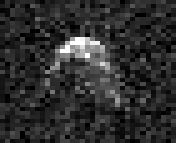Astrophysicist urges calm as 1,000-foot asteroid heads for Earth’s orbit
A leading space scientist from Leicester says there is no need to panic about a giant asteroid bigger than the Eiffel Tower passing across Earth’s orbit – but says tracking is vital in avoiding future catastrophe.
NASA has issued a warning about the 1,082-foot rock, which is due to come within 4.6 million miles of our planet on December 11, putting it in the ‘potentially hazardous’ category.

Asteroid 4660 Nereus will fly past the planet at 14,700 miles per hour and will be the equivalent of 10 times the distance between the Moon and Earth away, which scientists say will be as close as near-Earth asteroids go.
However, Professor Martin Barstow, Professor of Astrophysics and Space Science at the University of Leicester Director of Strategic Partnerships at Space Park Leicester, says there is nothing to worry about.
“Collectively asteroids do pose a potential threat, as the dinosaurs found out 63 million years ago. Scientists are interested in groups of asteroids for this reason and it is vital that we track them, because one day we might find one that could cause a problem, although that prospect is unlikely.”
Professor Martin Barstow
Professor Barstow, who is the Chair of the UK Space Agency Science Programme Advisory Committee as well as the Space Telescope Institute Council, added: “The things that we are really scared about are the things we don’t yet know anything about. That’s why we have initiatives to search space to find these objects and the Double Asteroid Redirect Mission to help protect us in the event that one might collide with Earth.
“As part of this mission, last month NASA launched a spacecraft the size of a refrigerator, sending it on a crash course with an asteroid in 2022. This intentional self-destruction will tell us if slamming a spacecraft into an asteroid is enough to save Earth in the future if a massive space rock is headed our way.”
NASA considers anything passing within 120million miles of Earth a Near-Earth Object (NEO), with thousands tracked by scientists to monitor whether they’re on a collision course with our planet.
Fast-moving objects in space that come within 4.65 million miles are considered to be ‘potentially hazardous’, with one small change to their trajectory potentially leading to disaster for Earth.
Astronomer Eleanor Helin first spotted Asteroid Nereus in 1982. As it passes by Earth fairly frequently, NASA and the Japanese space agency (JAXA) have previously considered ‘punching’ it off course. Space Park Leicester is a £100million research, innovation and teaching hub home to space-related high-tech companies and researchers. It is led by the University of Leicester in partnership with Leicester City Council and the Leicester and Leicestershire Enterprise Partnership (LLEP).


